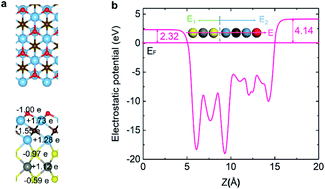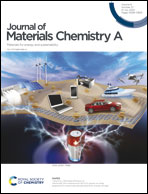An asymmetric Ti2CO/WS2 heterostructure as a promising anchoring material for lithium–sulfur batteries†
Abstract
The practical applications of lithium–sulfur (Li–S) batteries are greatly hindered by their low cycling stability and low efficiency, which mainly stem from the dissolution and diffusion of lithium polysulfides in the electrolyte. To tackle these challenges, here we construct an asymmetric polar Ti2CO/WS2 heterostructure to simultaneously trap lithium polysulfides and accelerate reaction kinetics. Van der Waals inclusive density-functional theory computations are carried out to uncover the unique role of the asymmetric heterostructure in the enhancement of the performance of Li–S batteries. In particular, we find higher adsorption energies of high-order lithium polysulfides on the O-terminal side, which helps to restrain the shuttle effect in Li–S batteries. Meanwhile, the S-terminal side of the heterostructure possesses a lower diffusion barrier and decomposition barrier, being specifically favorable for fast electrochemical processes. The analysis of the density of states of Ti2CO/WS2 shows the metallic character of the system; this guarantees the high conductivity and fast electron transfer of the proposed electrode. All these features illustrate that such asymmetric heterostructures could be promising anchoring materials for advanced Li–S batteries.



 Please wait while we load your content...
Please wait while we load your content...